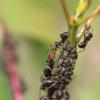I've been anting for several years and have accordingly discovered some helpful resources for locating specific ant species. I have a pretty hefty blacklight, a portable generator and various homemade sheet-propping contraptions that limit the scope of my night-collecting endeavors to state boundaries or however far I can drive. It's a sweet life.
Of course, it's helpful to know what species I may potentially stumble upon before I make a far drive. The United States Department of Agriculture National Resources Conservation Service (USDA: NRCS) publishes a Web Soil Survey that allows you to specify an area of interest (AOI: <100,000 m2) and provides a full, detailed report of soil in the area. If you don't know what kind of soil to be looking for, look up soil conditions of a known location, and try to find the same code elsewhere. For example, if I know I've seen Pheidole tysoni at location X and am interested in locating more Pheidole closer to home, I'll use the AOI tool to confirm location X's soil type and try to find matching or similar conditions at location Y.
Soil composition is by no means a reliable indicator of predicting species diversity at any location, but it helps give a frame of reference. I don't expect to find Trachymyrmex septentrionalis in clay or loam, but it may very well be worth checking sandier spots, if I can find them.
Hope this helps with your future anting expeditions!
Edited by VoidElecent, June 5 2020 - 11:54 AM.
















